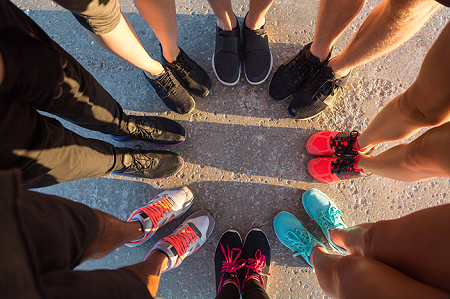Spring Newsletter 2021
In This Issue…
Meet Our Doctor: Dr. Taras Vysotskyy
The Right Shoes for Outdoor Fitness
The ABCDE’s of Skin Cancer on Your Feet
Meet Our Doctor: Dr. Taras Vysotskyy
Dr. Taras Vysotskyy
Dr. Taras Vysotskyy was born and raised in Western Ukraine and came to the United States in 2000. Dr. Vysotskyy attended the New York College of Podiatric Medicine in New York where he earned his Doctor of Podiatric Medicine. Following his medical degree, Dr. Vysotskyy completed his residency at Northport Veteran Affairs (VA) Medical Center in New York where he treated thousands of patients in one of the busiest hospital–based clinics in New York State. His residency encompassed hospital–based care as well as both inpatient and outpatient surgeries. While there, Dr. Vysotskyy refined his skills in limb salvage, fore and rear foot reconstruction, ankle arthroscopy, minor trauma, plastic reconstructive procedures, management of complex fractures and all aspects of foot and ankle treatment. Dr. Vysotskyy was appointed chief resident in his final year at Northport.
In 2017 Dr. Taras Vysotskyy relocated to the Hudson Valley and joined Sims & Associates Podiatry. Working alongside Dr. Sims and Dr. Dubal, Dr. Vysotskyy continues to hone his skills as a podiatrist and provide the best treatment and medical care for the foot and ankle. Like all the physicians at Sims & Associates Podiatry, Dr. Vysotskyy is focused not only on providing top notch foot care but doing so with patient satisfaction and comfort in mind.
“I enjoy getting to know my patients personally before we ever talk about their feet. Doing so allows me to get a better sense of what treatment options will work best for them. Just as every injury is different, so is every person and their treatment. Getting to know them helps me recommend the best treatment for their foot or ankle condition,” said Dr. Vysotskyy.
Dr. Taras Vysotskyy resides in Poughkeepsie with his wife and two children. He enjoys fishing, hiking, swimming, and working on cars. He gives back to the community by volunteering and participating in various health and wellness events.
Click here to book an appointment with Dr. Taras Vysotskyy or learn more about him.
The correct shoe for the activity
The Right Shoes for Outdoor Fitness
Sunny days and warmer temperatures invite outdoor exercise. Walking, running, and hiking are all excellent ways to get moving and enjoy fun and fresh air. Before you head out, however, you’ll want to make sure you’ve got the right footwear for your activity. Below are some tips for choosing shoes that will increase comfort and help protect your feet from common sports injuries.
Walking – Here’s the easiest way to savor a spring day! Walking can be done spur of the moment, on your own or with friends, and requires no special preparation or fancy equipment–except a good pair of walking shoes. In general, walking shoes should be lightweight and offer good shock absorption. Other features should be tailored to your specific feet. Overpronators, for example, will benefit from a more rigid midsole and reinforced heel counter, while those with flat feet will want additional arch support. You may not realize it, but your podiatrist can help analyze your gait and recommend the best walking shoes to accommodate your unique feet and conditions.
Running – Shock absorption is also important in running shoes to protect feet from the repetitive stress caused by pounding the pavement. The motion of running–foot rolling from heel to toe–requires a shoe that is flexible in the ball of the foot. Look for running shoes made of breathable material to reduce the chances of athlete’s foot and fungal infections.
Hiking – Don’t make the mistake of thinking you can just wear your sneakers (or, even worse, sandals or flip–flops) to go hiking. An important way to prevent podiatric injuries is to match your shoes to your activity. Hiking shoes and boots are designed with specific features to protect your feet on the trail. This includes a sturdy tread to give you traction on trails and solid ankle support to reduce the risk of ankle–twisting sprains. Although you’ll want a sturdy material to protect your feet from rocks and sticks, it’s also important that hiking shoes allow for ventilation to avoid excessive perspiration and blisters.
Getting a Good Fit
When buying any type of fitness shoe, proper fit is paramount. It’s best to go to a specialty shoe store and start by having your feet professionally measured. Wear the same type of socks to shop that you plan to wear with the shoes you are shopping for. Take your time assessing fit and comfort. Always try on both shoes and try them out with the movement you’ll be using during the activity. Make sure your fitness shoes feel comfortable before you walk out of the store.
If you experience any foot or ankle discomfort after exercising, be sure to make an appointment with us to track down the source.
Know what cancer can look like on your feet
The ABCDE’s of Skin Cancer on Your Feet
May is Skin Cancer Awareness Month and its placement in the calendar is no accident. As more people move out of their winter–and this year COVID–cocoon and into the sun, it’s the best time for some reminders on how to prevent skin cancer. The skin on your feet is just as vulnerable to the harmful effects of the sun’s rays as the rest of your body. Always apply a broad–spectrum, water–resistant sunscreen with an SPF of at least 30 to your feet whenever they will be exposed. This includes shopping days when you’re wearing sandals as well as beach and pool time.
One of the other keys to prevention when it comes to skin cancer is regularly examining your skin for any suspicious changes. Knowing your ABCDE warning signs makes it simple to assess your feet. If you have a freckly mole or spot on one of your feet, check for the following:
A – Asymmetry – imagine drawing a line down the middle of the spot–if both halves look the same, it’s symmetrical, if they appear different, it’s asymmetrical.
B – Border – freckles with poorly defined, irregular, or scalloped borders
C – Color – look for spots with various colors or a mottled appearance with shades of brown, tan, or black and/or areas that look red, blue, or white.
D – Diameter – spots that are the size of a pencil eraser or larger.
E – Evolving – the freckle or mole appears to have changed in size, color, or shape since the last time you examined your feet.
Be sure to include toenails in your self–check because cancers can develop under the nail as well.
If you notice any of the warning signs above, you must make an appointment with us as soon as possible to get an evaluation of the concerning spot. Even if you’re unsure that a mole or freckle meets the ABCDE criteria, it’s always better to be safe and get it checked out. Skin cancers are among the most curable types of cancer if caught and treated in their earliest stages.
Trivia
True or False: Wearing tight shoes or high heels can increase your risk of getting a type of tumor in your foot.
Answer: True
Explanation: Morton’s neuroma, a benign nerve tumor, is linked to wearing high heels and shoes with tight toe boxes -- so women get it 8 to 10 times more often than men. It’s a thickening of the tissue around a nerve heading between the third and fourth toes. The shooting pain feels like stepping on a hard kernel of corn. Another surprising cause: positioning your toes abnormally. Golfers, who twist the foot when swinging, are neuroma–prone.
Help Us Grow
Follow us on social media and subscribe to our newsletter!



